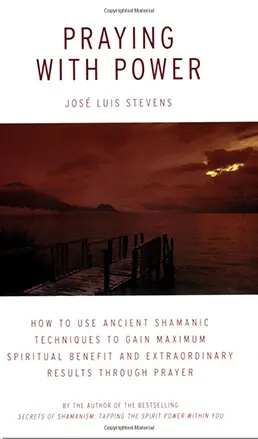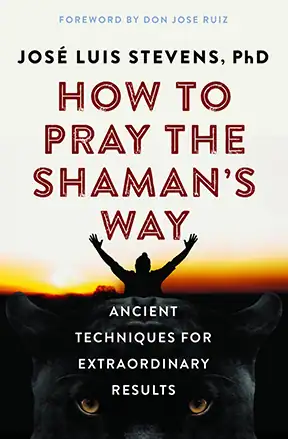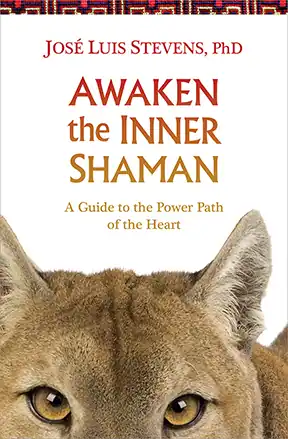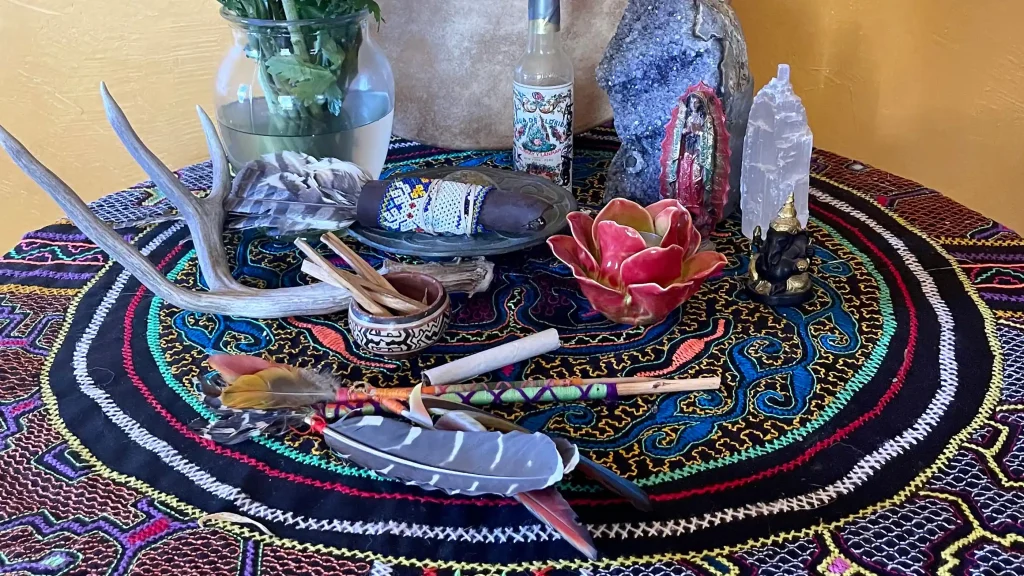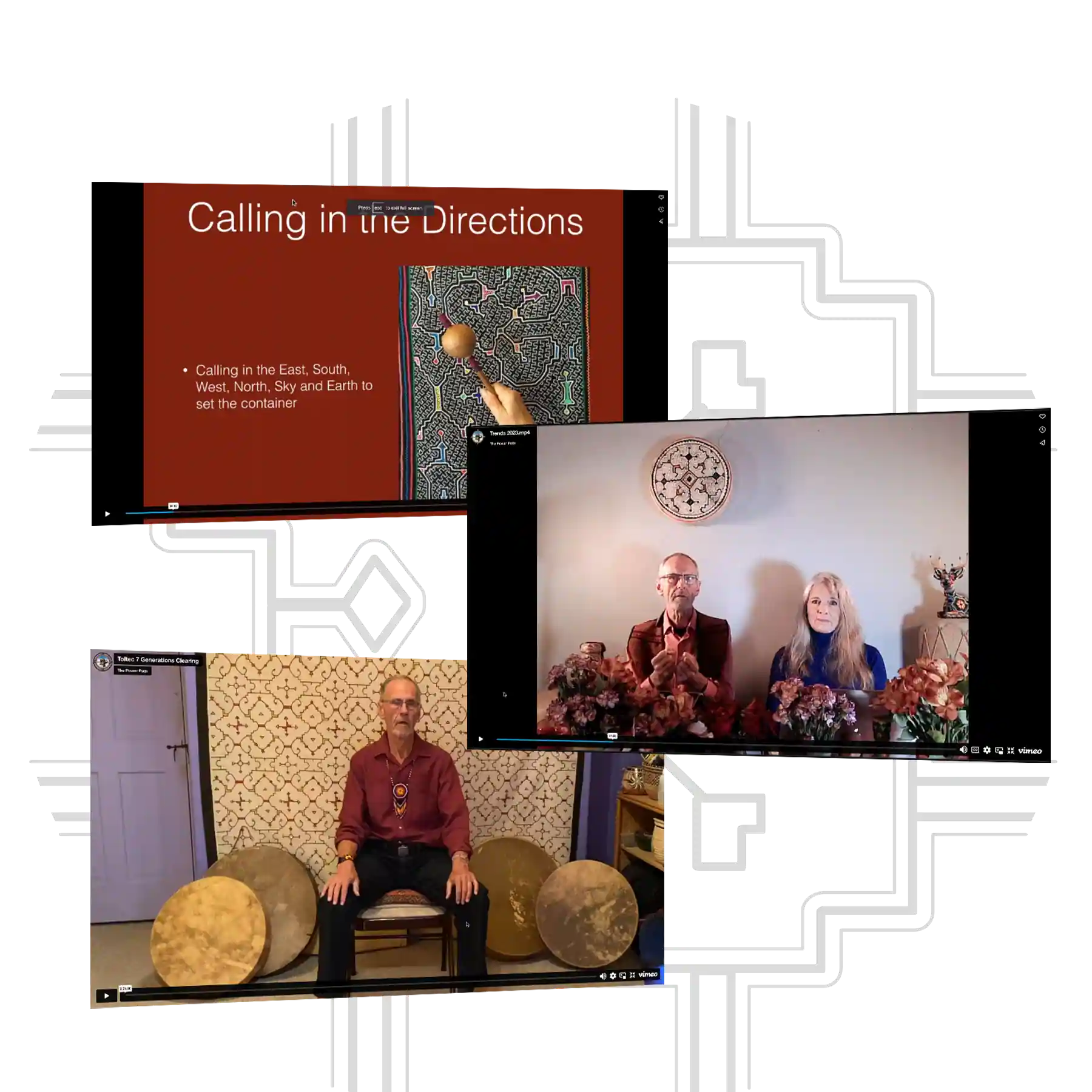Table of Contents
History of Shamanic Healing
Shamanic healing is a practice dating back at least 75,000 years and is the most ancient healing tradition known on the planet. It stems from the belief and understanding that all healing has a spiritual component and that the spiritual, emotional, and energetic need to be treated in order for a person to be well.
Overview of Shamanic Healing
The shamanic perspective is that everything is alive and everything has spirit and awareness. Energy and matter are the same. Everything is vibration and everything that exists is an energy system within a greater energy system. Shamans hold the belief that everything that exists is connected to everything else in a web of energy or life and unseen/inner/spiritual reality affects visible reality.
Working within this system of perceptions, the shamanic healer strives to create balance and harmony of the spirit. This is a physical, mental, emotional, and spiritual balance and can be focused on the individual or the community. This also can be applied to anything that exists. Shamanic healers act as intermediaries between the Spirit world (or non-ordinary reality) and the physical world.
By using shamanic practices, a wide spectrum of healing is possible. Shamanic healing takes place in many forms, depending on what Spirit recommends. This can include plant, herb and mineral spirit medicine, the use of song and other instruments to move and transform energy, visualization, soul retrieval, extraction, hands on massage or physical body manipulation. The shamanic practitioner understands the necessity to use both nature and spirit in healing and that true healing is whole and complete: body, mind and spirit.
Related Articles
Is Every Shaman an Intuitive Healer?
Yes, every shaman by definition has training in healing and this training includes developing intuitive skills, reliance on intuition, and extensive practice in shamanic healing techniques that includes praying, singing, soul retrieval, shamanic extraction methods, shamanic journeying, working with allies and spirit animals, and a host of other approaches requiring the use of intuition. Simply put, every shaman worthy of the name is an intuitive. So, it would be true to say that at the core of shamanic healing is intuition.
Conversely would it be true to say that every intuitive healer is a shaman? No, it is not true because not every intuitive necessarily has training in shamanic ways of seeing the world, nor are they trained in many of the techniques that shamans use. For example, central to a shaman’s work is the communication with and use of allies, singing as a form of healing, and shamanic journeying. Not all intuitive healers are trained in these methods nor do they automatically have this information. This does not mean that many intuitive healers are not highly competent because they can be, yet some may not know anything about the work of shamans.
In our programs at the Power Path we have advanced training programs that support learning the ways of shamanic healing and also intuitive skills training programs that support developing healing abilities and other natural skills.
Shamanic Intuitive healing is nature based so it always involves the use of natural elements like the light of the sun, moon, and stars, the energy of the earth, the elements, earth, air, fire, and water, plants, animal allies, and so on. It relies more on tried and true ancient technologies related to perception, sight, sensing, knowing, and feeling while it does not discredit modern technologies, the insights of quantum physics1, and the latest scientific discoveries related to health science. The shamanic perspective as we have come to understand it is that the future belongs to the marriage of modern science and the ancient understandings of shamanic tradition, both/and rather than either/or.

Intuitive Skills Training Series
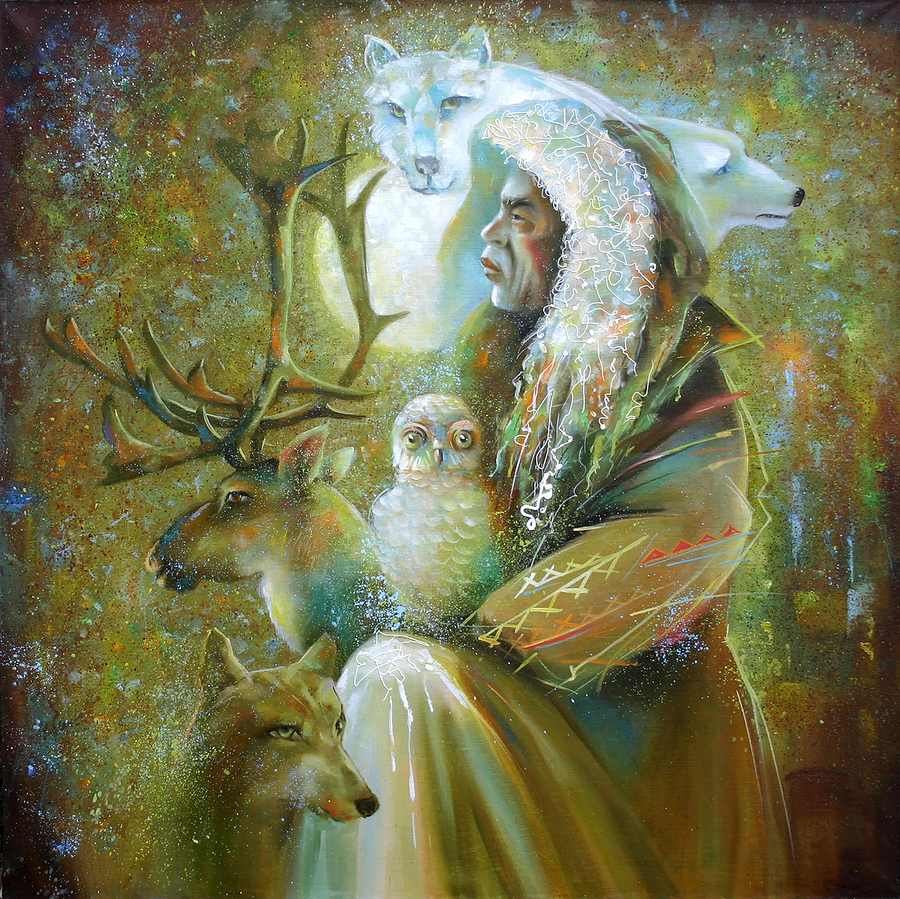
The Power Path to Working with Allies and Elementals
What Is a Shamanic Healing? What Should I Expect?
Shamanic healing starts with an interview to find out what the symptoms are, how long the person has been having them, as well as severity and type of pain and other pertinent information such as whether the person has been seen by a medical doctor and what types of medication the person is taking. The practitioner then prepares themselves, usually by silently observing the patient in a meditative state, by asking their allies or helping spirits and the patient’s allies to help them see what is needed in the healing.
Depending on the information they receive they may take various approaches to the healing using the proper shamanic tools for the job. Since most problems come from dammed up flows of energy, the most common approach is restoring circulation and movement of energy in the body.
The practitioner may use sound healing with a drum or rattle, feathers, tobacco, crystals or other tools to clear resistance in the form of fear or anger patterns, get circulation moving again, restore lost parts of self, or energetically extract foreign energy or obstacles. Occasionally they may use simple Shipibo/Conibo massage techniques (from the Ucayali River in the Upper Peruvian Amazon). Commonly, the practitioner will sing, whistle, or hum traditional healing songs.
Shamanic healings are generally short, between fifteen minutes to half an hour, but in some cases, they can last up to an hour.
While it is common for the practitioner to charge a modest fee for such work, they should never manipulate the client by suggesting that only they can save the patient nor should they charge exorbitant fees or make any inappropriate sexual innuendos or touch the patient in an unacceptable way.
Becoming a Shamanic Healer
Becoming a shamanic healer does not mean abandoning one’s knowledge of first aid or all the knowledge gathered through training in various modalities. Indeed medical doctors, physician assistants, nurses, chiropractors, dentists, naturopaths, psychologists2, psychiatrists, Social workers, acupuncturists, practitioners of Chinese medicine, massage therapists, and many other types of practitioners have training in shamanic healing and use it adjunctively to their training in their various fields of specialization.
Shamanic healing addresses areas that most medical training does not cover so the knowledge is complementary and supports and assists in other healing modalities. An example of this would be that, in addition to tending to a person’s physical wounding, a shamanically-trained practitioner would also help to energetically address any emotional or psychological disconnection induced by the wounding. An extraction or removal of an energetic parasite may be needed in addition to the administration of medication for anxiety or depression from an allopathic doctor. Sometimes de-cording may be necessary, a cutting of energetic cords to an intrusive person such as a relative or acquaintance. Often a shamanic practitioner will call in an ally to help or offer some extra protection for the patient from a plant or animal ally. In most cases it is not a question of either allopathic treatment or shamanic treatment but both/and.
Shamanic healers are particularly skilled at identifying trauma either long past or recent and tending to the repercussions of its presence in the individual or in the family structure. Shamans are aware that healing goes beyond physical stitches, setting bones, surgery, or pharmaceutical medications. Healing takes place at many levels and the impact of trauma may be deep and pervasive in the patient’s life. A shamanic practitioner knows that even though physical healing has taken place the traumatic impact of an accident or event often requires attention even years later. This is why they use techniques like soul retrieval, shamanic journey method, and extraction not just for physical foreign bodies like shrapnel but energetic intrusions that are not detectable to the unpracticed eye. The practitioner may also use such techniques as removing epigenetic and ancestral patterns through specialized Toltec extractive methods and the Tibetan Bonpo practice of duplication. Shamanic practitioners may at times direct the patient to focus their attention on specific parts of their body and especially locations in the brain.
-
Product on saleAncestral Clearing PackageOriginal price was: $149.99.$112.49Current price is: $112.49.
-
Product on saleToltec Prophecies: Preparing for the FutureOriginal price was: $49.99.$37.49Current price is: $37.49.
-
Product on saleToltec 7 Generations Ancestral ClearingOriginal price was: $69.99.$52.49Current price is: $52.49.
Being Called to Be a Shamanic Healer
Many people already trained in allopathic medicine or with no prior training at all feel the call to study and apply shamanic healing methods perhaps through reading about it, taking a class or workshop about it, or after experiencing its positive effects on themselves. Part of the attraction is that it is not complicated and does not require a lot of machinery, fancy technology, or mechanical tools. Most shamanic healing can be accomplished using very few external tools like a crystal, a rattle, a drum, a feather, or a pipe. In a pinch or an emergency all external tools can be dispensed with and the practitioner may simply use their hands, their voice, their breath, and their intention. A song or a prayer may accomplish what would otherwise require a whole hospital if that is not available.
A shamanic practitioner is also not restricted to healing humans but often has the opportunity to apply these skills and techniques to plants and animals as well. A dying plant may be restored to vitality, a spooked horse can be calmed, an injured animal can be treated very easily with very simple applications.
The main medical kit a person with shamanic training carries is in their mind, hands, and voice that enables them to extract blockages, encourage circulation and flow, call in allies and helping spirits, and call back in life enhancing energy and vitality, calm anxiety, lift depression and hopelessness all with simple prayer songs, hand movements, shifting of fields of vibration, decrees, and cleansing with various smokes of medicinal plant substances among other techniques.
Shamanic practitioners know that most problems are a result of disconnection and that reconnection to life heals. Many people with only allopathic training do not know this as it is not part of their training curriculum.
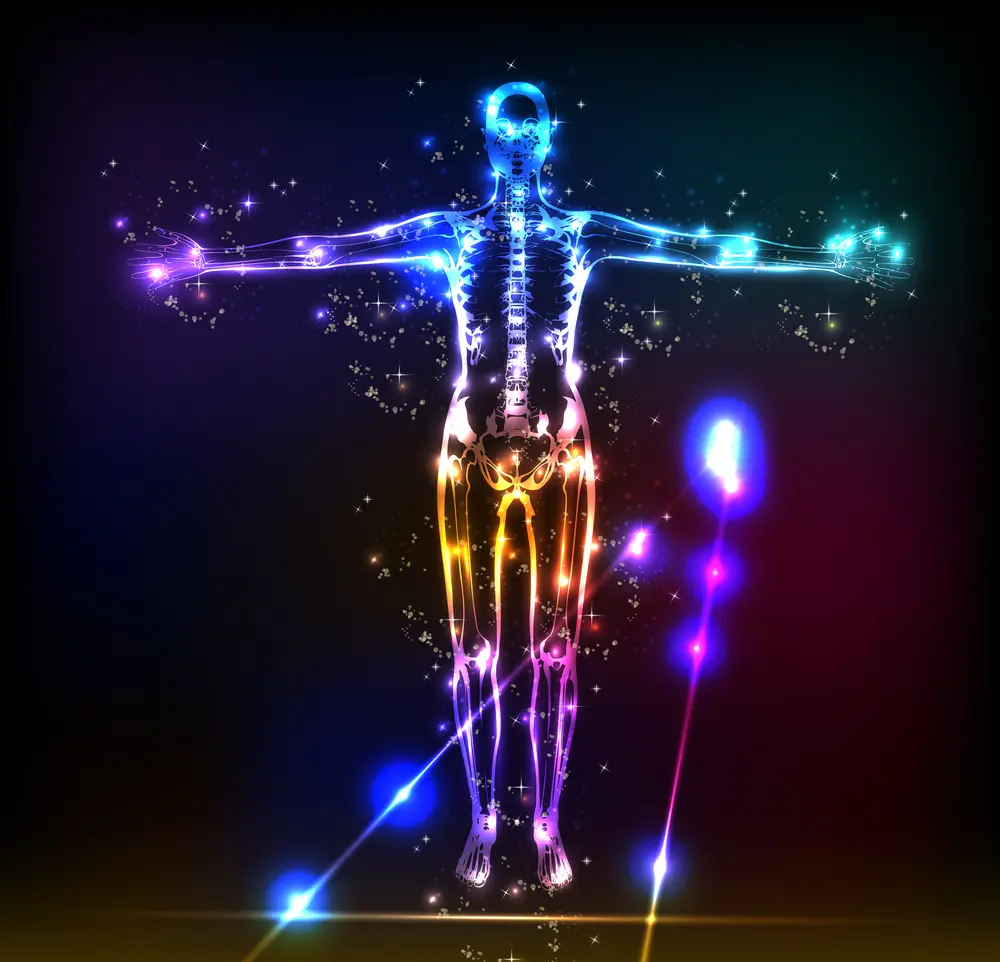
Health and Wellbeing: Supporting the Body Package
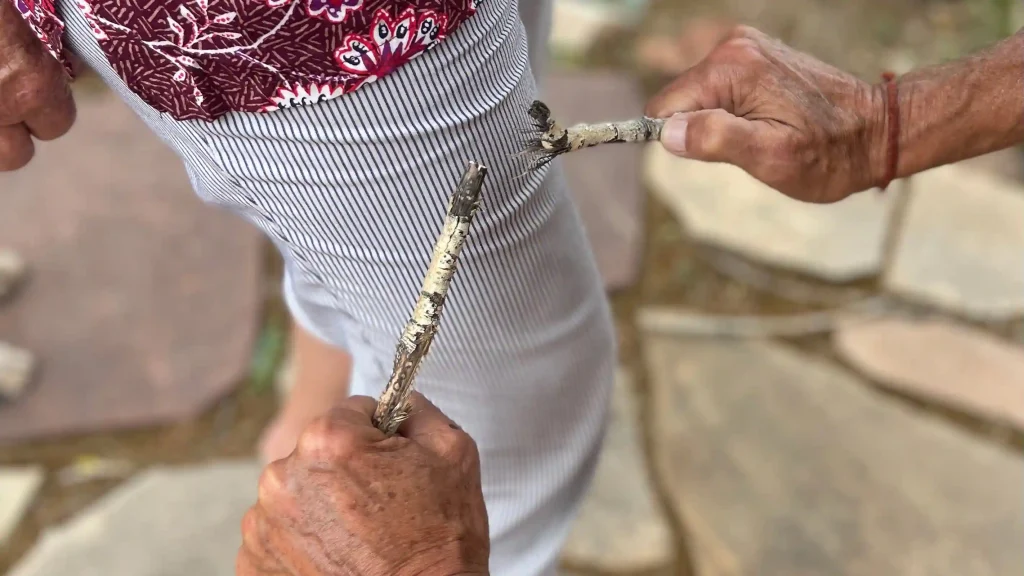
Shamanic Healing Techniques for Self Care
Shamanic healing is nature based and operates on simple principles of common sense. Here are some examples:
A man broke his arm and after visits to the emergency room to set the bone and apply a cast, it would not mend after many weeks. Doctors were completely puzzled and had no solutions. The man went to an indigenous medicine man who looked it over and grunted. Then he stated, “We need to have a fire ceremony and weld it back together.” During the ceremony the healer popped a blazing hot coal in his mouth and holding it in his teeth blew through it like a torch onto the injured arm. After a time he spit out the coal and said, “There, it is welded back together.” After the ceremony the man was able to use his arm again because it was perfectly healed. Granted this was performed by a veteran and experienced shamanic practitioner with many years of experience working with his ally, the spirit of fire.
Another man was being treated for extremely high blood pressure problems. His medical doctor was flummoxed because nothing was working. He told the man he would probably have to live with this condition because it was not responding to any treatment. The man left and heard about a Philippine psychic surgeon (Filipino shaman) passing through town and on a whim went to see him because he was out of options. The Filipino shaman prayed and then performed a type of surgery on his neck using only his hands. He pulled out some bloody chunk of putrid flesh and then he told the man he was done and that he would be fine but that it was important that he have faith in God. He went back to his doctor for a checkup and the doctor was astounded. There was no trace of the high blood pressure. The patient asked his doctor if he wanted to know what had cured him. The doctor thought for a moment and then said, “No, I don’t want to know.” The patient never had the problem again. The medical doctor never found out what the truth was.
A woman had been struggling with seizures for many years. Many medical doctors had treated her to no avail. She came to a free shamanic healing clinic where shamanic practitioners were being trained. The instructor was using her as a demonstration. She lay down on a table face up and explained to the class what the problem was. The instructor demonstrated how to ask an ally for help and then simply followed the allies’ instructions being given to him mentally. The instructions were to extract something red and black from her temple by sucking it out and spitting it into a bowl. She regained more color in her face and hands and her pallor went away. She sat up and said that she felt different, somehow better. Then she left. A number of months later she called in and reported that the seizures had completely stopped from that day forward.
A man was suffering from a rapid onset of a viral infection that included a raging sore throat, fever, and chills, and severe feelings of illness. He asked the local shaman for help. The shaman looked him over and then began to sing him a song that lasted several minutes. At the end of the song, he asked the patient how he was feeling. The sore throat had completely receded, there was no more fever and chills, and the man felt perfectly fine. The shamans said that he had been taken over by a fierce little demon and he chased the demon out with his song. The man had recovered instantly. The virus did not return.
These are all examples of shamanic practitioners applying their skills to heal people of a variety of maladies. They needed few if any external tools. They used different methods depending on their traditions but the results were all the same, an almost immediate cessation of symptoms of illness with no future recurrence. In all cases there was either no fee or a nominal fee for the services.
Brief Explanation of Healing Tools
These are all covered in much more depth in our one-year shamanic studies program and advanced healer practitioner training.

View The Power Path One Year Shamanic Studies Program
The purpose of this program is to learn about the shamanic path, from ancient to modern through powerful practices, ceremonies, much time in nature, wilderness solos and other shamanic experiences, to assimilate its wisdom and integrate it fully into daily life.
Shamanic Soul Retrieval and Shamanic Journey Method
These are often the methods shamanic healers employ as part of their healing approach when called for. That is to say that they are not always the method used to accomplish the best results but sometimes are. They may be used in conjunction or separately for different purposes.
Shamanic Soul Retrieval
This is the term used to describe a certain method of healing. We feel that the term is a bit misleading in that the soul is always present and does not need healing. However, it is true that sometimes, just like with memory, there may be a miscommunication or an obstacle to the person’s ability to communicate internally with their own essential or core self. In this case the soul retrieval method is very effective at retrieving aspects of self that have felt disconnected, not unlike retrieving lost or suppressed memories.
The soul retrieval can be performed in two ways that we know of. The traditional way is for the shamanic practitioner to go into a light trance while sitting or lying down accompanied by drumming while the patient sits or lies quietly as well. Before they actually begin there is an interview or discussion about when the patient first noticed this disconnection or lost part and how it has impacted them. They may discuss earlier traumas that may have been the origin of the problem.
After this nothing more is required of the patient as the practitioner does all the work. The practitioner asks for a guardian Spirit or ally to accompany them to wherever that lost aspect of the patient might be. They may travel to the lower world or the middle world to retrieve that part. If and when found that aspect of the self typically shows up at the biological age when it was lost or disconnected, perhaps when a child and as a result of a trauma such as the loss of a parent or sibling, abuse, or an accident or illness. When the aspect is found the practitioner petitions for it to return now that the situation is safe. There may be some reluctance or fearfulness on the part of this lost aspect to return and some persuading may be needed.
If successful, the aspect agrees to come with the practitioner to be reunited with the patient. The practitioner may have the experience of carrying this child on her back or in his arms back to the room where they are lying or sitting. Then the practitioner blows their essence back into the patient’s crown or chest. Finally, there is some adjusting to the return and some discussion about what happened. The results are often profoundly beneficial.
The second method is much like the first with the exception that the practitioner guides the patient in the process of retrieval which they do themselves. We prefer this model because it empowers the patient to be an active participant in their own healing. If the patient is too afraid or distressed this method is then not the most effective one and the practitioner should step in and do the work relieving the stress on the patient.
Booking A Shamanic Healing
Available with either José or Anna.
If you have any questions or would like to book a shamanic healing please call the office at 505-982-8732 or [email protected]
Shamanic Journey Methods
A brief review of the method is as follows
As you have seen the soul retrieval utilizes the shamanic journey method to accomplish its aims. However, the shamanic journey method can be used for many other endeavors as well. For example, the practitioner may use the journey method to go in search of lost knowledge or to look for an object that has been stolen. This is a primary tool used by Kenyan shamans to track down a criminal and the items they may have stolen. They are so good at this that the police often use them in their own investigations. The shaman is able to describe with absolute accuracy in whose home the objects are, what they are, and who the culprit is perhaps what other objects they have stolen. The evidence proves them out.
The shamanic practitioner may also use this method to retrieve lost information, or perhaps important objects that may have been left somewhere by mistake. They may go back in time to find out more about what happened around a particular event. They may be able to track down the whereabouts of a long lost relative or friend. The possibilities are almost endless. This makes the shaman a highly effective detective and in times past they were the detective agency so to speak. We know of a doctoral student who used a shaman to track down important research papers and other supporting information they were seeking. Note that not all shamans are specialists in these particular areas.
De-cording
De-cording, as mentioned above, is a specialized technique for disconnecting a patient with energetic ties to another person which are deemed not good for them. An example might be a woman involved in a damaging relationship with a boyfriend or husband who is controlling and abusive to the patient. Sometimes the abusive person may be a relative who tries to manipulate or control their child psychologically, emotionally, and even energetically with cords. The patient may complain of headaches, backaches, pain in the neck, chest or abdominal area. The shamanic practitioner uses the strong eye (term used by aboriginal shamans in Australia for inner sight) to see if and where the chords are attached. It is not unusual for them to be found in the back spinal region of the patient. It is often a painful area. The practitioner asks permission to detach the cord and in most cases receives permission. Using a variety of methods, the cord is severed or pulled out not unlike an electrical cable pulled out from an electrical outlet. This technique requires training and should not be tried without adequate protection. In the case where a guru is involved it may be necessary to leave the cord in place.
Praying
Praying is one of the shamanic practitioner’s main tools. There are times when only the Lord’s prayer is spoken out loud, usually at the end of the healing. However, most prayers are non-traditional and spontaneous to the occasion and frequently they are sung directly into the patient. They can be whistled, hummed, or sung with external words and gestures taking out illnesses or guiding in healing energies. Any language may be used. At times the prayer is sung into alcohol which is then sprayed on the patient, into water which may be drunk by the patient, or into tobacco whose smoke may be blown on or around the patient.
Remote Healing
For a Shamanic practitioner, distance is not an obstacle. At times the practitioner may be separated by a physical distance, perhaps being in different parts of the country or even in different countries. The Shamanic healing can be performed over a Zoom session, a telephone connection, or even without any media connection at all. It may be that the patient is in the hospital and can receive no visitors in person. It may even be that the patient is dying and the healing session has to be done remotely because they are in a far-away location.
In most cases the healing can be performed the same way as it is done in person.
In the event that the person is out of media contact, the practitioner may use a reasonable representation of the patient: A photograph, a drawing, a doll, teddy bear or other stuffed animal, an action figure, even a bottle of water is a good facsimile.
It is best if the healing is done at a prearranged set time taking into consideration time zones. In this way the patient can be aware of the healing as it is taking place. However, the healing can ultimately take place at any time at all because at the end of the day, time and space are not limitations in shamanic healing. They are simply artifacts of the physical plane.
Join Us at a Remote Healing Ceremonies
Each month, around the new and full moons, Jose, Lena or Anna leads a remote shamanic healing session. These approximately 30 minute sessions are designed to be experienced in a quiet, safe place free from distraction.

Shamanic Healing Tools
During a shamanic healing the practitioner has a choice of a number of traditional tools to employ. Feathers, rattles, bells, drums, clicking sticks, tobacco and other smokes, Flowers, crystals, semi-precious stones, essential oils, and alcohol in the form of Agua Florida or other mixtures may be used.
Feathers
Feathers from the wings and tails of various birds may be used as a tool to sweep away or extract illness, promote circulation of energies, or insert light and vitality. Bird feathers have unique and powerful qualities. They have flown over vast landscapes in the course of the bird’s life and are energized and filled with potency. Depending on the qualities of the bird they may be used for different purposes. Vulture feathers remove and clean just as these birds do in the natural cycle. Predator birds can take out illness and bring in much light. Songbirds are filled with light as well and can impart this to the patient. The feathers of a dead bird, perhaps roadkill, are not dead themselves. They carry the essence of the bird and have amazing properties. Just passing the tip of one of these feathers near the palm of the hand reveals a current of vitality and flow of energy that is palpable.
Rattles
Rattles break up energy that has become constricted or damned up in the body or the energy field. A brief rattling near the body area involved can produce quick relief from stress or tension.
Bells and Tuning Forks
These produce high amplitude and frequency and can lift up areas of tension, depression, fatigue and generally bring inspiration to the patient. This is a very big area of study and specialty.
Drums
Drums can either break up congealed energies or they can carry the patient and/or the practitioner into altered states that heavily promote healing. The drum can be used during the journey method or for soul retrieval purposes.
Clicking Sticks
These break up ancestral patterns that may be causing dysfunctional behavior or illness. They are used for dispersing stubborn areas of resistance to healing.
Tobacco
This plant is an ancient plant of the Americas that has been used for thousands of years to accompany and send prayers. Tobacco is an excellent medium for songs, prayers, and intentions that can be blown directly into the patient’s energy field to clear maladies and loosen resistance to healing or to insert encouragement, hope, and more positive outlooks. Tobacco can be used both for cleansing and for inserting healing songs into the body.
Other smokes such as burning sage, incense, copal, and palo santo are used to shift the atmosphere, clear the air so to speak, and bring cleansing to a person’s energy field or to a healing space or even to clear a house.
Flowers
Flowers are often brought in to assist with blessings and to generally raise up the atmosphere in the healing space. Even imagined flowers have great potency and this is also a much bigger topic than can be covered here.
Crystals and Semi-Precious Stones
Quartz crystals and other semi-precious stones can be of great help in the healing space. They may be placed on particular body parts or along the spine to promote circulation, enhance a healing flow of energy, or in some cases can impart protection or certain qualities associated with that stone.
Generally speaking, black stones like obsidian are used to remove maladies and bright crystalline stones like citrine are used to bring in light and protection. Again, this is a vast topic that can be studied for a lifetime.
Essential oils
These can be used to promote certain states of awareness of a healing nature. They can promote relaxation, a state of receptiveness, reduce tension and stress, and connect a person to their wisdom and vitality. They are often used to bless people and promote spiritual awakening.
Alcohol
Alcohol is used by shamans the world over as a significant healing tool. Generally speaking, wood alcohol is not used because it cannot be taken internally. Ever-clear used in Agua Florida, sugar cane alcohol or aguardiente, and sometimes rum are sprayed by mouth on to the patient or around their energy field. Alcohol is considered to be a primary carrier of prayers and healing songs. It can be rubbed on the skin, placed on the temples or crown and so on. The alcohol is often infused with the essence of spices like cinnamon, flowers, prayers, and songs, and specific healing intentions. Only a few drops are taken internally to introduce a prayer, a song, or healing to the body itself.
Greater amounts are generally not used with the exception of Shamans from Guatemala who are prone to using copious amounts of rum in their ceremonies. Unfortunately with the outlawing of the use of sacred plants for altering consciousness, many shamans have turned to alcohol to induce altered states and this has caused problems for shamans in many countries including Mongolia, Guatemala and other countries in Central and South America.
Summary
There is, of course, much more to shamanic healing that has been written here because shamanic healing has been around for many thousands of years and has a rich history. It is, after all, the ancestral healing method predating all of western medical practices of the modern world. This does not mean that it has been entirely replaced by modern allopathic medicine. Shamanic healing continues to be a primary source of healing for millions of people around the world and an adjunctive form of healing for many millions more. Shamanic healing continues to be a powerful approach that includes age old methods and diagnostic tools now lost to allopathic medicine to its detriment. Fortunately, increasing numbers of western trained medical doctors are now aware of the contributions and value of shamanic healing, especially when they have run out of options for helping their patients using modern methods.
Footnotes
2 https://en.wikipedia.org/wiki/Psychotherapy








